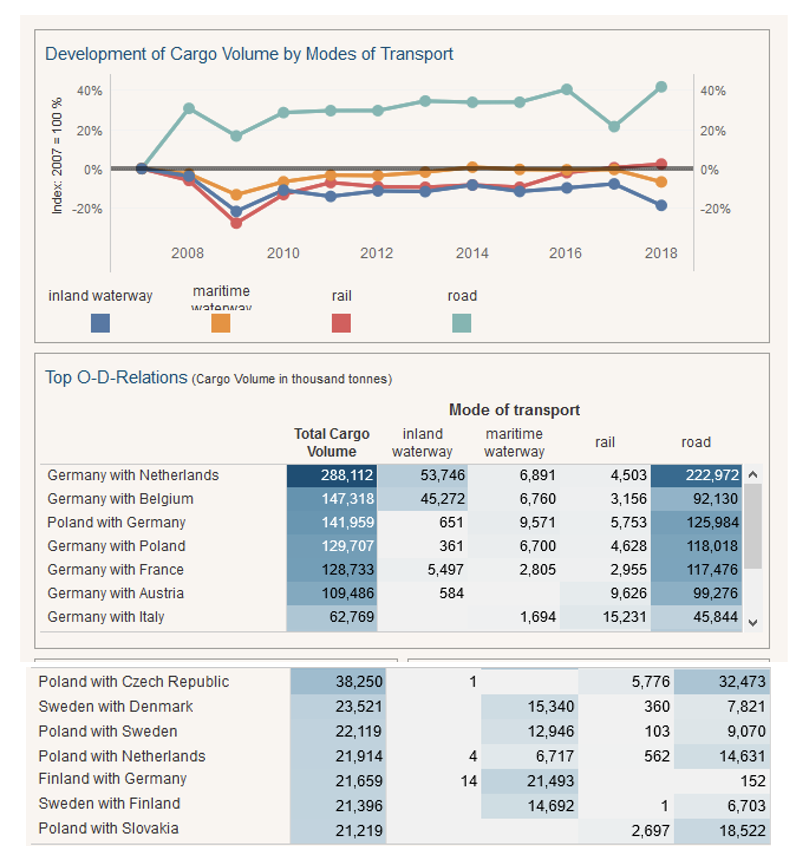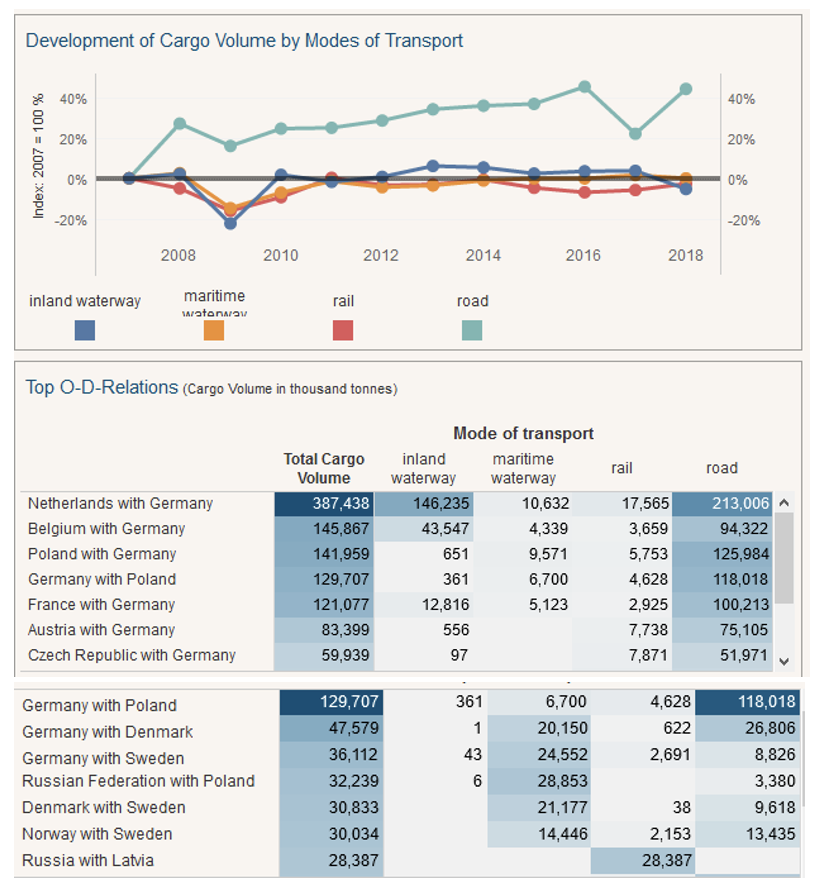Due to unaggregated and inconsistent data connected with the different understanding of definitions exact trade flows, especially in CT traffic between BSR countries is hard to describe. Although, three sources of data which are Eurostat, UIRR, and UIC can give a strong foundation to at least sketch a flow of cargo across BSR.
First source of data is the Eurostat which provides the numbers on transported goods between BSR countries in tonnes. Unfortunately, the data includes the modes of transport only, excluding the type of cargo. Thus, potential to shift the goods from road to CT in BSR is hard to estimate. Data provided, shows, that most of the cargo exported from BSR counties travels on the road, with relatively small share of other means of transport, i.e., export from Poland to Germany is in almost 90% arranged by road, with some share of rail and maritime waterways. Trade between Poland and Lithuania is in 85% transported by road. Due to geographical location the traffic from Scandinavia to continent is mainly arranged via maritime waterways.
Trade flows to/from Scandinavia use mostly maritime waterways, both container short sea and roro traffic. Cargo coming/departing from/to the Western Europe (Benelux, France) is more balanced between different transport means. Eastern side of BSR characterize bigger share of the trade flows transported by rail. Mainly in terms of import from Russian Federation using the broad-gauge infrastructure. It is clearly visible in cargo flow to Lithuania from Russia or Belarus, where almost 100% of cargo is transported by rail, mostly in conventional wagons.
The biggest exporter in BSR countries is Germany which export in terms of tonnes generate most of the cargo traffic in BSR and EU (above 1.3 bln tonnes per year). Most crowded lanes includes the routes to Benelux, Poland, and France. Second biggest exporter is Poland with almost 0.5 bln tonnes and the biggest potential in traffic to Germany and Czech Republic but also to Sweden, Netherlands and Slovakia. Other important cargo flows in BSR includes the internal traffic in the Scandinavian countries and Scandi to Germany and Poland.

In terms of import the biggest potential shows Germany (almost 1.4 bln tonnes) with the biggest trade exchange with the neighbors: Benelux, Poland, France, and Czech Republic. Second place belongs also to Poland with the 0.4 mld tonnes of cargo imported mainly from Germany but also from Sweden, Netherlands, and Czech Republic. Other important routes indicates intra Scandi traffic and the trade exchange between Germany and all Scandi counties.
Considering import to BSR countries from outside partners it is also visible flow of cargo from Russian Federation which has big potential to shift to CT due to constantly developing transcontinental traffic rail from China to Europe.

Much more detailed data in CT traffic can be extracted from the statistics provided by UIC/UIRR. Unfortunately, the data consists only from the CT operators included in UIRR union.

Analysis of those database showed, that between 2007-2018 the development of CT units transported in BSR rose by almost 18%, whereas in all Member States the rise is on approx. 27% level. The most frequented lanes in terms of CT from/to BSR are Trans-Alpine corridor Germany-Italy with 1.3mln TEU transported in 2017. The second place is occupied by Germany-Netherlands (200,000 TEU transported). The third place, which might be a surprise, belongs to Germany-China corridor, and it response for above 100.000 TEU in 2017. Most probably the share of this corridor will increase in the further statistics as in 2020, market observed significant rise of rail traffic between China and Europe. Other important lanes connected with German economy are corridors to France/Benelux but also to Czech Republic and Hungary.
Excluding Germany from the UIRR BSR statistics, other promising lanes for CT development are Sweden and Denmark from/to Italy (approx. 40,000 TEU in 2018), probably with new corridors from Sweden via Poland, and corridors from Poland to Adriatic/ Black Sea area.
Historic data does not show relevant statistics for CT in Baltic countries. It is directly connected to lack of access to the European rail gauge and needed infrastructure. However, the development of Rail Baltica will probably lead the countries to reach fast increase of CT volumes in next years.
Average distance of transported ITU in BSR is considered at approx. 1500 km, with the weight of 20tonnes. In terms of equipment, above 50% of transported units consists of swap bodies and containers below 8 meters. Huge share of short containers and swap bodies is directly connected with its usage in Trans-alpine corridor. On the other lanes in BSR much bigger share of 40’ sea containers and huckepack trailers can be observed.